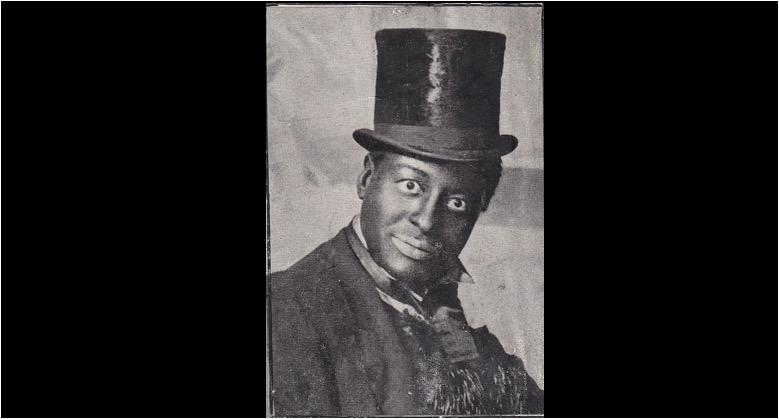On this day in comedy on November 12, 1874 Comedian, Actor, and Recording Artist, Bert Williams was born in Nassau, The Bahamas.
Williams became known as the greatest comedian of the first half of the 20th Century. Fellow Vaudevillian W. C. Fields said of Williams that he was “the funniest man I ever saw and the saddest man I ever knew.” Williams arrived at this perceived melancholy mainly due to the times in which he lived. Williams was an educated, cultured man who was not born with American values; meaning he didn’t have a baggage of racial injustice pumped into him from an early age. So any undeserved slight or poor treatment was more of an affront compared to Blacks raised in the States who knew it was nothing personal. It was because you were Black.
Williams defied barriers. While working with various minstrel shows on the West Coast he met his future partner, George Walker and they made history. Billed as “Two Real Coons” (so they weren’t confused with many of the white minstrels billing themselves as real coons), their routine consisted of skits, funny dialogue and song-and-dance numbers. In 1896 they popularized the dance craze, The Cake Walk and simultaneously they were criticized for not being better role models. After all their stage personas were that of a slick dandy (Walker) and a dimwitted coon (Williams). This knocking of the duo was despite the fact they were always dressed immaculately and used exquisite manners when in public and in photos. Few seemed to notice their mockery of the very blackface they employed with pointed satirical jabs at the process. No matter. They were derided, whereas the truth was they became the first to move away from the broad style of minstrelsy and portray a more naturalistic, human brand of comedy. They even touched upon the divisions of class in the Black community.
Then came the turn of the century. After Walker was beaten by a mob in New York following a performance (he was mistaken for a ‘darkie’ who’d shot a cop), the duo had a string of major stage successes, most notably Son of Sam and In Dahomey (the first Black production to open on Broadway). The latter production did a command performance at Buckingham Palace in London and Williams and Walker were initiated into the Edinburgh Lodge of the Freemasons, because the Scottish weren’t into discriminating racially as the Masons were in the USA. The twosome recorded hit songs in 1901 (Williams had the hit, Nobody). They did Bandanna Land where Williams introduced his signature routine, The Card Game. He pantomimed an entire poker game alone.
When Walker contracted syphilis in 1909, suffered a stroke and later died, Williams was forced to become a solo act. His first production was met with resistance from an organization known as “The White Rats’, who intimidated theater owners who were sympathetic to hiring Black acts. Thus Bert Williams did not gain the support needed to mount a successful run. He flopped and went back to vaudeville. The White Rats went right with him to protest his working. Regardless, he was too good not to hire, but the theater owners put him as secondary to a lesser headliner even though they put Williams name in larger letters to draw a crowd and lend legitimacy to their show.
Despite the persistent interference of the White Rats Williams was hired to perform in the Ziegfeld Follies in 1910. Many of the white performers threatened to quit. Owner, Flo Ziegfeld told them they’d be missed. Williams was a huge success and became the top paid act in the Follies. He recorded four songs under his new contract with Columbia Records and they were hits. He was paired with white entertainer, Leon Errol for a hilarious 20 minute routine and they became the first black and white comedy teaming. However, Williams was also featured in 1913 in the all-Black revue, The Frogs, giving his Black fans who couldn’t make the Follies a chance to see him.
By 1914 things were slowing down at the Follies for Bert Williams. The focus was more on the parade of beautiful girls the show featured than on comedy routines and Williams got less and less stage time. In 1918 Williams worked in Ziegfeld’s secondary production known as “Midnight Frolic” and thrived in this setting because it allowed him longer stretches on stage. During that same period he was being touted as one of the three top recording artists in the world (along with Al Jolson and Nora Bayes) shipping out 180,000 copies at a time when 10,000 was considered a major feat.
Massive success aside, Bert Williams still faced racial prejudice. Once while attempting to buy a drink at the bar of the Hotel Astor, the bartender threatened to throw him out if he couldn’t pay $50 for the glass of liquid. Williams pulled out a wad of $100 bills, slapped them on the bar and demanded drinks for everyone in the establishment. Such disrespect continued all the way up to his death in 1922 from pneumonia. He had stubbornly performed while ill to save a dying show and collapsed on stage, only to say in his dressing room, “That’s a nice way to die. They was laughing when I made my last exit.”
Bert Williams had a World War II battleship named in his honor and was inducted posthumously into the International Clown Hall of Fame in 1996.
By Darryl “D’Militant” Littleton
Check out this clip:


